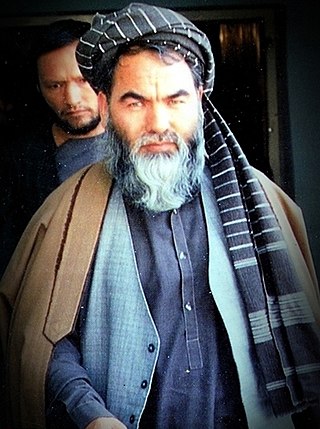Related Research Articles

Abdul Ali Mazari was an Afghan Hazara politician and leader of the Hezbe Wahdat during and following the Soviet–Afghan War, who advocated for a federal system of governance in Afghanistan. He believed that this would end political and ethnic division in Afghanistan by guaranteeing rights to every ethnic group. He was allegedly captured and murdered by the Taliban during negotiations in 1995.

Paktika is one of the 34 provinces of Afghanistan, located in the eastern part of the country. Forming part of the larger Loya Paktia region, Paktika has a population of about 789,000, mostly ethnic Pashtuns. The town of Sharana serves as the provincial capital, while the most populous city is Urgun.
The Kharoti (Pashto:خروٹی) خروټی) are a Pashtun tribe of Ghilji origin, originating in the central part of Paktika Province, Afghanistan, but can be also found in other parts of the country. The Kharoti settled in Kharotabad in Quetta, British India around 1945.

The Ghiljī also spelled Khilji, Khalji, or Ghilzai and Ghilzay (غلزی), are one of the largest Pashtun tribes. Their traditional homeland is Ghazni and Qalati Ghilji in Afghanistan but they have also settled in other regions throughout the Afghanistan-Pakistan Pashtun belt. The modern nomadic Kochi people are predominantly made up of Ghilji tribes. The Ghilji make up around 20–25% of Afghanistan's total population.
The Islamic Revolutionary Movement of Afghanistan is a traditionalist Islamist political party. It was once one of the biggest Afghan mujahideen factions fighting against Soviet forces during the Soviet–Afghan War. Mohammad Nabi Mohammadi was the leader of the group at the time.

Mohammad Nabi Mohammadi was an Afghan politician and mujahideen leader who was the founder and leader of the Harakat-i-Inqilab-i-Islami political party and paramilitary group. He served as President of Afghanistan under the mujahideen from January 1993 to 1996.

Jaghori is one of the main districts of the Ghazni province in Afghanistan. It is located in the highlands in the southern fringes of the Hazaristan region. It occupies 1,855 km2. in the upper Arghandab valley. The population is estimated to be around 560,000 in 2015. The district capital, Sange-e-Masha, is where major business transactions take place. The district is heavily dependent on agriculture, and migrant workers as the main sources of income. Other major marketplaces are in Ghojor and Anguri.
Malistan or Malestan, is a district in Ghazni province, Afghanistan. Its population, which is 100% Hazara, was estimated at 350,000 in 2009. The district capital is Mir Adina.

Abdul Haq was an Afghan mujahideen commander who fought against the Soviet-backed People's Democratic Party of Afghanistan, the de facto Afghan government in the 1980s. He was killed by the Taliban in October 2001 while trying to create a popular uprising against the Taliban in Afghanistan in the wake of the September 11th attacks.

The 1992–1996 Afghan Civil War, also known as the Second Afghan Civil War, took place between 28 April 1992—the date a new interim Afghan government was supposed to replace the Republic of Afghanistan of President Mohammad Najibullah—and the Taliban's occupation of Kabul establishing the Islamic Emirate of Afghanistan on 27 September 1996.

Andar is one of the eastern districts of Ghazni Province in Afghanistan. The population has been estimated at 88,300, all Pashtun. The district center is Miray while the other main town is Andar. The district is named after the Andar Ghilji tribe of the Pashtuns. The district also contains the town of Sardeh Band on its edge near the border with Paktika Province.
Zana Khan district is a mountainous district in Ghazni province, Afghanistan with more than 12,000 people living there. The district center is Dado.

The Afghan mujahideen were Islamist resistance groups that fought against the Republic of Afghanistan and the Soviet Union during the Soviet–Afghan War and the subsequent First Afghan Civil War.

Mata Khan District is a district of Paktika Province, Afghanistan. The district is within the heartland of the Andar tribe of Ghilji Pashtuns. The estimated population in 2019 was 26,720.
Qila Niazi is a village located near kabul Afghanistan. It is about 135 kilometres (84 mi) south of Kabul.

Hezb-e Wahdat-e Islami Afghanistan, shortened to Hezbe Wahdat, is an Afghan political party founded in 1989. Like most contemporary major political parties in Afghanistan, Hezb-e Wahdat is rooted in the turbulent period of the anti-Soviet resistance movements in Afghanistan in the 1980s. It was formed to bring together nine separate and mostly inimical military and ideological groups into a single entity.
The Sulaimankhel, or Suleiman Khel, are a Pashtun sub-tribe of the Gharzai tribe. As they are primarily Nomadic People. In the early 20th century, the tribe was recognized as generally pastoral.
Gulakai Kot (ګوړاکای کلى یا شیرکل کوټ) is a remote village in Afghanistan. It is located at the district of Shwak, in the eastern province of Paktia. It belongs to Shabak Khel tribe, one of the five major Zadran tribes.

The Hazāra of Muḥammad Khwāja is one of the major tribes of the ethnic Hazara inhabiting and originating mainly from Ghazni, Afghanistan.

Commander Shafi Hazara was an ethnic Hazara military commander in Afghanistan. He was a senior commander during the resistance of west Kabul and Hazarajat between 1991 and 1996. In the 1990s, he led Hezb-e-Wahdat’s “Brigade 2” military wing against rival militias and, against the Taliban takeover.
References
- ↑ H.A. Rose, p. 244
- ↑ Dupree, Louis (1997). Afghanistan (2nd ed.). Oxford Pakistan Paperbacks. p. 40. ISBN 978-0-19-577634-8.
- ↑ Gilles Dorronsoro, Revolution Unending: Afghanistan, 1979 to the Present. New York: Columbia University Press, 2005. 167